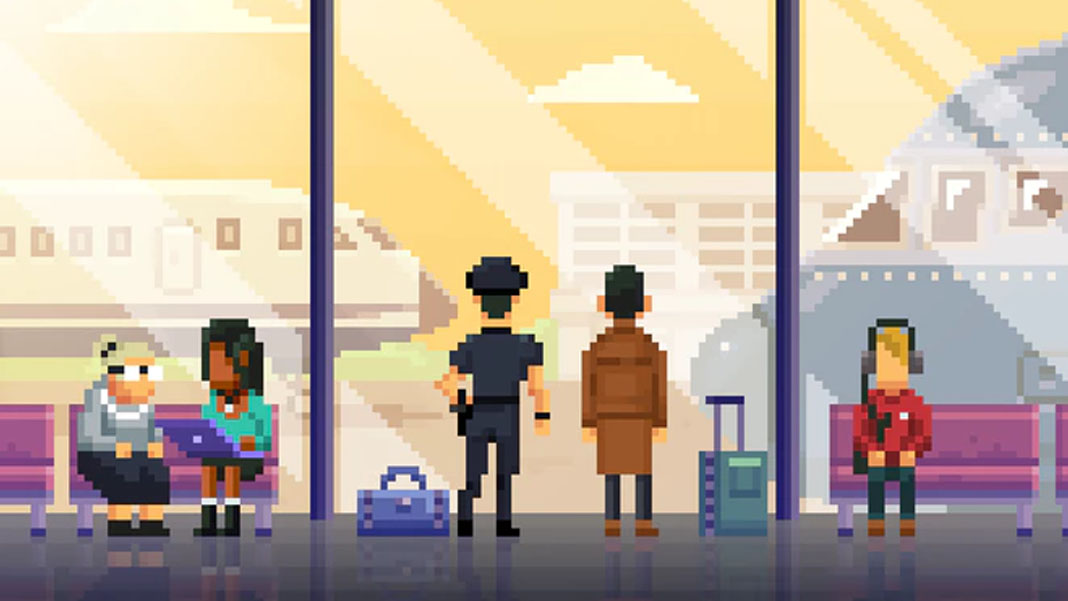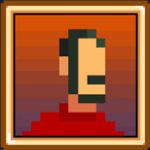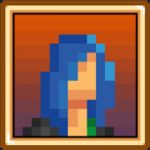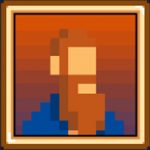After covering the Kickstarter for The Darkside Detective: Season 2, Cliqist followed up with the project’s Ireland-based developer, Spooky Doorway, for an email interview.
As the developing game’s title indicates, this is not Spooky Doorway’s first trip to the Darkside. Released on multiple platforms, The Darkside Detective was Spooky Doorway’s first game, and now it’s first in their plan for a series. Telling the case-by-case story of Detective Francis McQueen and Officer Patrick Dooley’s mission to safeguard the paranormal Twin Lakes, The Darkside Detective won awards, positive reviews, and even a spot in a book.
Developer Spooky Doorway talks about that and more, including Irish stereotypes, Americana icons, and not always being an occult comedy.
Cliqist: Thanks for taking the time for this interview. First of all, could you please introduce yourselves?
Paul Conway: I’m Paul Conway. I’m the artist here at Spooky Doorway. All the pixels are pushed by me, and I’m also responsible for all the silly GIFs that end up online.
Treasa McCabe: I’m Treasa McCabe. I’m the techy person; I do coding, project wrangling, and design along with the others.
Dave McCabe: I’m Dave McCabe, I write words. Hopefully they string together to form jokes from time to time.
Game Jam Origins
How did your team Spooky Doorway come together? Did you all meet at a Game Jam?
Treasa McCabe: I met Dave through marriage. Paul, we met on a secret game dev retreat on an island off the west coast of Ireland. The three of us got on well and wanted to work on something together. When The Darkside Detective came along, it seemed like a good fit!
Your website says the first season of The Darkside Detective started at a Game Jam. Could you please tell us more about that experience?
Conway: The original demo came from a game jam in Galway City on the West Coast of Ireland, all the way back in November 2014. I was one of the organisers with a friend, Chris. It was a short jam, only twelve hours, and the theme was “hidden worlds.” After we’d gotten the event kicked off and all the admin out of the way, we decided to make a game in the time we had left.

Rough concept art for the Game Jam prototype that Paul Conway (artist) and Christopher Colston (programmer) made in 2014.
Chris and I both loved adventure games, so we decided to give one a shot. We referenced some TV shows we liked and adapted the “hidden worlds” theme to fit into an alternate dimension concept. The resulting demo, at that time simply called The Darkside, was utterly terrible. It was only four screens long and it made little sense, but I’d nailed a quick low resolution art style which seemed to work with the genre. When we posted the demo and the screenshots online, a lot of people responded to it quite positively. It had a charm that people really liked. I started to think then that there was a full game to be made from it.
How did the Game Jam prototype evolve into the final product? Were there a lot of changes? Or did a lot of the material stay the same while expanding upon it?
Conway: The core art style and the goofy paranormal setting remained intact, but other than some character names and a couple of sprites which we continued to use, the Game Jam demo was totally rewritten. Dave and Treasa came on board in early 2015 to take on narrative design and coding respectively. Their input really steered us away from the broken prototype, and we began to form a much more coherent and sturdy game.

How art for The Darkside Detective is made, as shown on the game’s dev blog. Part of the process involves adding HD colors and lighting to assets in Photoshop.
Did The Darkside Detective always have a comedic tone, or was it more serious and later evolved into a funnier story?
Conway: The demo had an odd mix of serious and comedy blended together in a micro pixel vignette. We started out making a serious game, but one silly gag popped into the script late in the day of the jam seemed to work more than it should have, and we tried to pepper the demo with as many silly jokes as we could. When Dave came onboard he took the sillier aspects of the demo and amplified them in his own unique way, which set the comedic direction of the game in stone.
Investigating the Darkside
Could you talk more about your influences for The Darkside Detective? Why did you make it a point and click adventure game? What draws you to that genre?
Conway: We all really like the adventure game genre; I’ve always appreciated being in the story and how funny the genre was. On the surface they seemed like they were easier to make than other games. The art and code overhead seem less than other games, and how hard can a script be, right?
We learned that lesson the hard way.
Dave McCabe: Twin Peaks; The X-Files; Blackadder, at least at first. I like adventure games—Space Quest V is a big favourite of mine—I’d love to make a game like that.
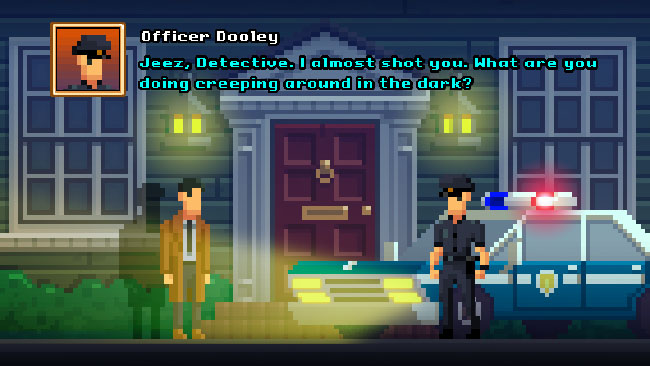
Why did you choose to set up each game as a season, incorporating an episodic format?
Conway: The short format started organically. The original demo and its more polished follow-up were both short, and we got a lot of positive feedback from that. We realised ourselves that we enjoyed the short format of the different cases, it fit easier into our lives as players, as well as developers. Players our age are mostly time-poor, busy with careers and families, so it’s nice to be able to sit down and play a game for a short period of time and have a small victory, instead of having to remember where you were and what you were doing last week. Another benefit was we got to play with a lot of different scenarios, so the game remained fresh for us throughout development.
Dave McCabe: I only get to play games sporadically, and with longer games I forget why I have all these weird items and what I’m doing. The shorter format came from that, really. And the no-walking. I hate when I have to waste half an hour on a walk animation in these things—it’s 100 percent padding.
Had you always planned for The Darkside Detective to span multiple parts when ending the first one on a cliffhanger? Or was it a rougher idea, with nothing set in stone?
Dave McCabe: We planned the first three seasons before designing any cases (barring the pilot). That plan has changed a lot, and we pushed the cliffhanger out from the base game as we knew we wanted to add extra cases, but a cliffhanger has been on the cards from day one.
Caseload for a Sequel
The Kickstarter for The Darkside Detective: Season 2 says the sequel will feature an in-game trip to Ireland. Can you talk more about adding your team’s home to the series?
Dave McCabe: We wanted to do something set in Ireland that was made by Irish people—no “top of the morning,” or “faith and begorra.” It won’t have leprechauns either.

It sounds like the sequel will feature a lot of different gameplay scenarios—the Kickstarter mentions “a fun fair, a retirement home, an amateur wrestling circuit,” and even a “high-school reunion.” How did The Darkside Detective: Season 2 wind up with that kind of variety?
Dave McCabe: We have a big list of Americana locales, another big list of spooky stories, and a third list of pun titles. We just picked our favs and dove in. We have a lot of neat stuff up our sleeves we’ve not talked about yet either. There’s a lot of room in the Darkside world for stories.
The season two Kickstarter said that sometimes developing a case for The Darkside Detective series goes smoothly, and sometimes a case needs more iteration. What factors make a case run more smoothly, and what factors require multiple iterations?
Conway: A lot of cases in season one had multiple iterations, and we had a few cases which were almost fully designed but were completely scrapped. Each case starts out with an idea, be it a scenario or setting which we think could be fun to work with. We’d throw some ideas around and all agree on something that we thought would work.
Then Dave and Treasa would go away and do a rough outline for the episode’s story and layout. This stage could go through several passes, but eventually when we’re happy with it, I’ll rough up some basic graphics and Treasa will assemble it. It’s usually at this point, in this ugly basic form, that we’d start identifying issues with the case flow. Areas may be confusing, or there might be too many clicks to get around, ruining the flow of the experience. We’ll re-work the structure here more often than not, then flesh the prototype case out more.

When the case becomes more built out, we always discover other issues such as overly difficult puzzles or areas which are tedious. Another two or three iterations could happen here before we’re able to get a case to flow as well as we need, or equally it could be scrapped if we just can’t make it work as well as what we’re aiming for. It’s safe to say the game is designed more than once, at first on paper and then several times in practice.
Have you planned for substantial change in season two, or do you intend to largely keep the material the same? Or are you planning for a mix of both the new and the familiar?
Dave McCabe: If it’s not broken, why fix it? The episodic formula works and lets us tell a wide range of stories from this one city. The only area we tinker with is case difficulty. We’re a small team and can only make so much content so fast—if we make the puzzles harder, then a case lasts longer, but maybe it’s too hard and ah, we’re still balancing that.
How do you plan to use your previous experience making The Darkside Detective for the development of its sequel?
Treasa McCabe: Dev-wise, we were streamlining the tools and dev pipeline while we worked on season one. Content-wise, it’s just more of the same in a way. The world became more of its own thing as it went on, and we started to lean into that more and more. You can expect more of the same in season two.
How do you approach puzzle design in The Darkside Detective games? How do you balance the level of challenge with accessibility?
Treasa McCabe: I have this rule—if my mam can’t play it, it’s too hard. We want to keep it casual, a fun way to unwind after work. We’ve gotten feedback from players on our Discord channel as to what worked and what didn’t. As we dev a case, we experiment with difficulties and throw it at our QA team (David Farrelly and Robert McGone) and, once they’ve caught the big issues, we try to get the cases to events and watch people play the game. That way we see who gets stuck where. Sometimes we streamline a case from that, other times we add in some extra guidance or a custom joke so that you still feel like you found something as you searched for the answer. That way it still feels like you’ve progressed in a way.
What steps do you take for worldbuilding in The Darkside Detective series? How do you create the cast and the world they live in?
Dave McCabe: When I started working on this way back when, I sat down—like I mentioned above—and listed all the things that are America to me. Mostly from TV and film of the 80s and 90s, but also from trips over there, and Americans I’ve met over the years. I’m a tabletop gamer too, so I’ve books on how to create this setting and that, and various city guides from games like Vampire: The Masquerade and so on. So you fill in a street here, a person there—over time it builds up.

According to the Kickstarter for The Darkside Detective: Season 2, there are 75,666 residents in Twin Lakes. (Over 140 of them showed up in the first season.)
The cast, it’s just who we need at the time, then there’s some messing around in my head to figure out this person, why are they here, what do they want, why are they gonna be fun, how do I write them to be different to everyone we’ve met so far, and distinct in a few sentences. Paul does the art separately, so there’s never a, “oh, they look like this so write them that way,” so everyone gets a little more depth and Treasa tells me if it’s dumb or not—a lot of the fun stuff comes from us talking over cases. We’re just trying to make each other laugh, then work backwards to how can this happen.
Awards, Book Publishing, and a Fan Following
The season two Kickstarter says that The Darkside Detective won at events like the Aggie Awards. Could you please talk more about that experience?
Treasa McCabe: We didn’t expect to get the nominations with such heavy hitters on the market, so it was really exciting. It was great to have done so well, especially the audience vote. At the end of the day, it’s the audience we’re making it for, so it’s gratifying to see they enjoyed it.
According to your website, The Darkside Detective was featured in The Art of Point-and-Click Adventure Games published by Bitmap Books. Could you tell us more about how that project came about, and what it was like to have your game in a book?
Conway: Sam Dyer of Bitmap Books reached out to us when he started working on the book. He had produced many cool books about video games up until that point, but he had big plans with The Art of Point-and-Click Adventure Games. He put a lot of work in covering the history of the genre, but he also wanted to include modern titles. Luckily for us, we had recently released The Darkside Detective and had received a popular reception. He invited us to have art from the game featured in the book. I was delighted to have my artwork represented in the book alongside so many other artists I admired throughout the years. Sam also hired me to design the cover for the special collector’s edition, which was quite an honour. I’ve still yet to receive my copy; they’re in the process of being sent out at the moment. I can’t wait to get my hands on it.
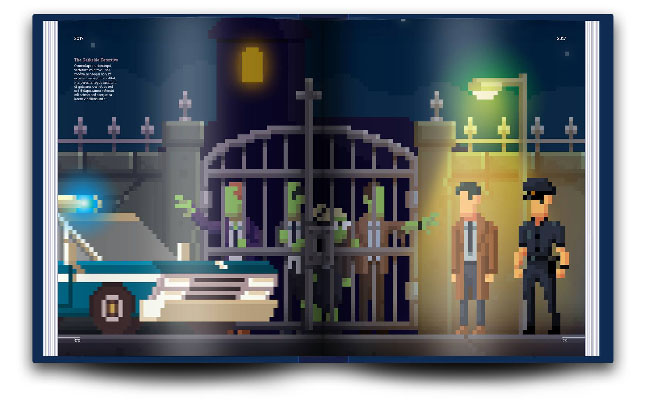
An excerpt from The Art of Point-and-Click Adventure Games featuring The Darkside Detective.
What has it been like seeing a fandom emerge around The Darkside Detective?
Treasa McCabe: It’s been great, really wonderful. Seeing the fanart and cosplay is my favourite part of it all. I want to get some of it printed out and hung in our office—maybe we can make that a stretch goal. (Note: The last part about the stretch goal was teasingly presented.)
Is there anything else you can share about The Darkside Detective: Season 2?
Dave McCabe: It’ll be better than season one.
Thank you Spooky Doorway for taking the time for this interview.

With the Kickstarter actually over halfway funded by this point, the forecast for The Darkside Detective: Season 2 looks bright.
The Darkside Detective ended with Detective McQueen separated from Officer Dooley when the latter became trapped in the Darkside, effectively playing the part of a season finale cliffhanger. This separation propels the story forward into The Darkside Detective: Season 2, and will serve as the first case for the player. But it’s not just about resolving a huge cliffhanger and satisfying an audience’s desire for “what happens next?” It’s about the characters themselves and their reunion—because ultimately, the core of this game’s world is the partnership between McQueen and Dooley.
And as McQueen and Dooley’s chemistry drive the game in-universe, so does the teamwork between Conway and the McCabes literally drive the game’s development. Individually specializing in different disciplines, and yet doing a lot of crossover in creative responsibilities while supporting each other and their shared vision, the trio work in sync to keep the team of Detective McQueen and Officer Dooley investigating the supernatural Twin Lakes together.
